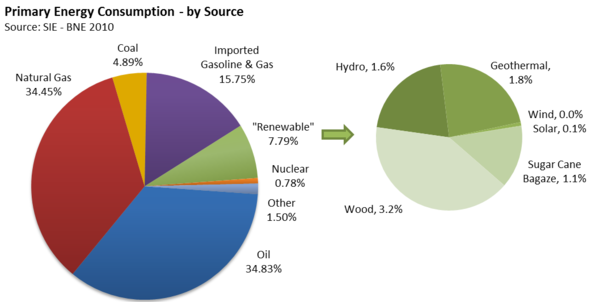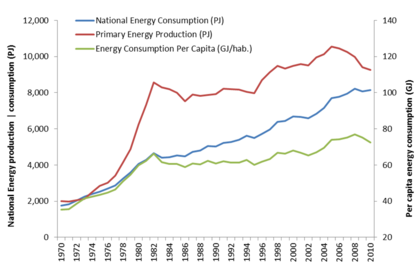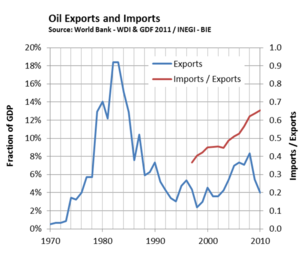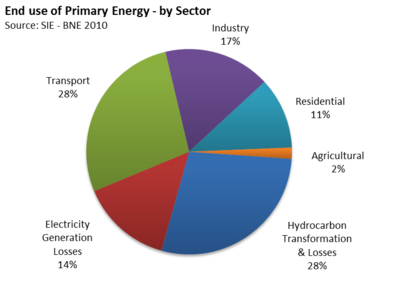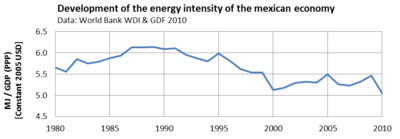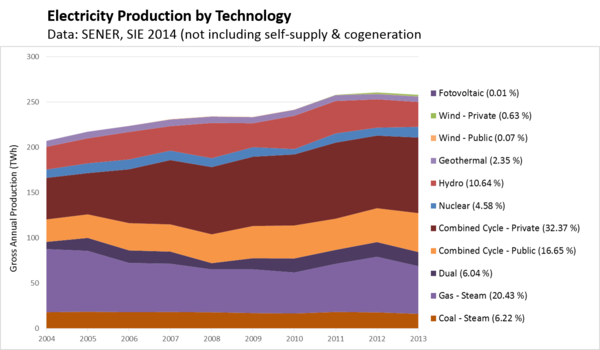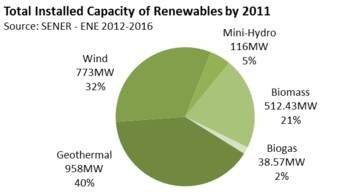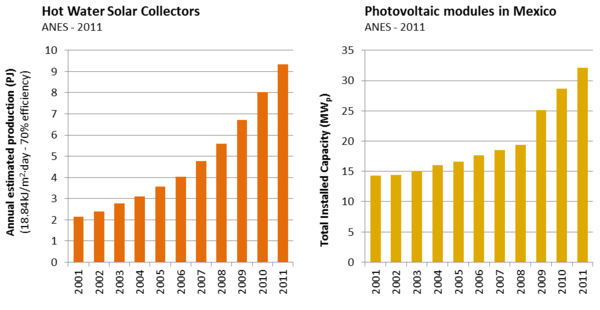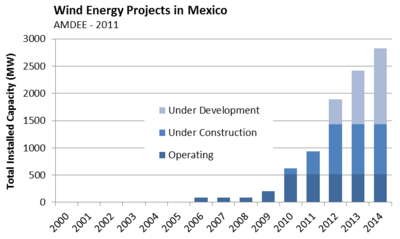Knowledge fuels change
For over a decade, Energypedia has shared free, reliable energy expertise with the world.
We’re now facing a serious funding gap.
Help keep this platform alive — your donation, big or small, truly matters!
Thank you for your support
Difference between revisions of "Mexico Energy Situation"
***** (***** | *****) |
***** (***** | *****) |
||
| Line 146: | Line 146: | ||
| − | <p style="text-align: center;">[[File:End Use of Primary Energy in Mexico - by Sector .png|400x282px|RTENOTITLE]]</p><p style="text-align: center;"></p><p style="text-align: center;"></p> | + | <p style="text-align: center;">[[File:End Use of Primary Energy in Mexico - by Sector .png|400x282px|RTENOTITLE]]</p><p style="text-align: center;"></p><p style="text-align: center;"></p><p style="text-align: center;"></p> |
Between 1998 and 2008 the energy demand of the industrial and residential sectors grew at the small annual rates of 0.6% and 0.9% respectively, and the commercial sector even shrank at a pace of -1.1%.<ref name="BNE2010">_</ref> Along with the decrease in oil production this rates might account for the modest reduction of the energy intensity of the economy. | Between 1998 and 2008 the energy demand of the industrial and residential sectors grew at the small annual rates of 0.6% and 0.9% respectively, and the commercial sector even shrank at a pace of -1.1%.<ref name="BNE2010">_</ref> Along with the decrease in oil production this rates might account for the modest reduction of the energy intensity of the economy. | ||
| Line 174: | Line 174: | ||
| − | <p style="text-align: center;">[[File:MEXCS RenewablesInstalledCapacity.png|center|350px|Add caption here]]</p> | + | <p style="text-align: center;">[[File:MEXCS RenewablesInstalledCapacity.png|center|350px|Add caption here]]</p><p style="text-align: center;"></p> |
| − | |||
=== Hydropower === | === Hydropower === | ||
| Line 181: | Line 180: | ||
The total estimated potential for large hydro (>40GWh/year) corresponds to an installed capacity of 52 GW, of which nearly 20% is already in operation. An overall production of 38TWh/year could be expected from the overall capacity. The potential for small hydro (5MW to 30MW) was estimated by CONAE in 2005 as 3.2GW, but so far no reliable estimates exist for micro- and mini-hydro.<ref>Valdez Ingenieros, Panorama actual de la mini-hidráulica en México http://www.cie.unam.mx/~rbb/Lic/luishectormicrohidraulica.pdf</ref>,<ref>Estimación del recurso para pequeña, mini, y micro hidroenergía, SENER - Valdez Ingenieros (2005) http://www.energia.mx/webSener/res/168/A8_Minihi.pdf</ref><ref name="ENE2012">_</ref> | The total estimated potential for large hydro (>40GWh/year) corresponds to an installed capacity of 52 GW, of which nearly 20% is already in operation. An overall production of 38TWh/year could be expected from the overall capacity. The potential for small hydro (5MW to 30MW) was estimated by CONAE in 2005 as 3.2GW, but so far no reliable estimates exist for micro- and mini-hydro.<ref>Valdez Ingenieros, Panorama actual de la mini-hidráulica en México http://www.cie.unam.mx/~rbb/Lic/luishectormicrohidraulica.pdf</ref>,<ref>Estimación del recurso para pequeña, mini, y micro hidroenergía, SENER - Valdez Ingenieros (2005) http://www.energia.mx/webSener/res/168/A8_Minihi.pdf</ref><ref name="ENE2012">_</ref> | ||
| + | |||
| + | |||
=== Solar power === | === Solar power === | ||
| Line 211: | Line 212: | ||
| − | <p style="text-align: center;">[[File:MEXCS WindDevelopment.png|center|400px|Add caption here]]</p><p style="text-align: center;"></p> | + | <p style="text-align: center;">[[File:MEXCS WindDevelopment.png|center|400px|Add caption here]]</p><p style="text-align: center;"></p><p style="text-align: center;"></p> |
The actual installed capacity is booming, and went from 2MW in 2006 to 1080MW by April 2012<ref name="ENE2012">_</ref><ref name="ACCIONA">_</ref>, it is expected that by the end of 2012 private and public projects will add up to 2.2GW, 4% of the electric installed capacity<ref name="ENTE2011">Estrategia Nacional para la Transición Energética y el Aprovechamiento Sustentable de la Energía http://www.sener.gob.mx/webSener/res/0/Estrategia.pdf</ref>. Most projects are located in the Isthmus of Tehuantepec, which according to AMDEE has a potential on its own of 10GW, offering wind power densities of more than 800W/m<sup>2</sup> and capacity factors in the range of 40%. La Rumorosa, in Baja California is apparently lagging behind, but might have 4.57GW installed within the next five years.<ref name="AMDEE">_</ref> | The actual installed capacity is booming, and went from 2MW in 2006 to 1080MW by April 2012<ref name="ENE2012">_</ref><ref name="ACCIONA">_</ref>, it is expected that by the end of 2012 private and public projects will add up to 2.2GW, 4% of the electric installed capacity<ref name="ENTE2011">Estrategia Nacional para la Transición Energética y el Aprovechamiento Sustentable de la Energía http://www.sener.gob.mx/webSener/res/0/Estrategia.pdf</ref>. Most projects are located in the Isthmus of Tehuantepec, which according to AMDEE has a potential on its own of 10GW, offering wind power densities of more than 800W/m<sup>2</sup> and capacity factors in the range of 40%. La Rumorosa, in Baja California is apparently lagging behind, but might have 4.57GW installed within the next five years.<ref name="AMDEE">_</ref> | ||
| Line 226: | Line 227: | ||
Mexico is the 4th place in the world in geothermal installed capacity<ref>Ren 21 Renewable 2011 Global status report http://www.ren21.net</ref>, with 958 MW (2011). The technology accounts for 2.53% of the total electricity production, but most of the resources available with the current plant designs seem to be already tapped. Installed capacity has fallen 7.6% since 2006, while only 186MW of proved reserves remain to be exploited. Recent studies, however, have suggested that up to 2.8GW producing 9.79TWh per year could be exploited using binary-cycle and condensation plants.<ref name="ENE2012">_</ref> | Mexico is the 4th place in the world in geothermal installed capacity<ref>Ren 21 Renewable 2011 Global status report http://www.ren21.net</ref>, with 958 MW (2011). The technology accounts for 2.53% of the total electricity production, but most of the resources available with the current plant designs seem to be already tapped. Installed capacity has fallen 7.6% since 2006, while only 186MW of proved reserves remain to be exploited. Recent studies, however, have suggested that up to 2.8GW producing 9.79TWh per year could be exploited using binary-cycle and condensation plants.<ref name="ENE2012">_</ref> | ||
| + | |||
| + | |||
=== Biomass === | === Biomass === | ||
| Line 239: | Line 242: | ||
The production of fuel ethanol should take off in the following years, as PEMEX will be buying up to 230 million liters anhydrous ethanol per year by 2017. This buy alone would add up to some 0.1% of the current final energy consumption. Other energy crops include Jatrhopa, of which 8,113 ha have been sown between 2007 and 2011, mainly in Chiapas and Yucatán. According to the National Institute of Agricultural & Forest studies (INIFAP) a total of 18,000ha could be used for bio-fuel crops<ref name="ENE2012">_</ref> | The production of fuel ethanol should take off in the following years, as PEMEX will be buying up to 230 million liters anhydrous ethanol per year by 2017. This buy alone would add up to some 0.1% of the current final energy consumption. Other energy crops include Jatrhopa, of which 8,113 ha have been sown between 2007 and 2011, mainly in Chiapas and Yucatán. According to the National Institute of Agricultural & Forest studies (INIFAP) a total of 18,000ha could be used for bio-fuel crops<ref name="ENE2012">_</ref> | ||
| − | More Information | + | |
| + | |||
| + | More Information: | ||
*[http://www.rembio.org Red Mexicana de Bioenergía (REMBIO)] | *[http://www.rembio.org Red Mexicana de Bioenergía (REMBIO)] | ||
*[http://www.semarnat.gob.mx Secretaría de Medio Ambiente y Recursos Naturales (SEMARNAT)] | *[http://www.semarnat.gob.mx Secretaría de Medio Ambiente y Recursos Naturales (SEMARNAT)] | ||
| + | |||
| + | |||
= Policy framework, laws and regulations = | = Policy framework, laws and regulations = | ||
| Line 257: | Line 264: | ||
<br/>The methodology to calculate these externalities is not specified, but article 10 of the LAERFTE states that they shall be calculated by SENER, with help from the SHCP, SEMARNAT and SS (Ministries of Economy, Environment, and Health, respectively) | <br/>The methodology to calculate these externalities is not specified, but article 10 of the LAERFTE states that they shall be calculated by SENER, with help from the SHCP, SEMARNAT and SS (Ministries of Economy, Environment, and Health, respectively) | ||
| − | |||
| Line 271: | Line 277: | ||
The government entity in charge of all aspects of energy regulation is SENER – Secretaría de Energía [Ministry of Energy], and three smaller entities take part in different areas: the CRE – Comisión Reguladora de Energía [Energy Regulatory Commission] for gas and electricity, CONAE – Comisión Nacional para el Ahorro de Energía [National Commission for Energy Savings], and CNSNS – Comisión Nacional de Seguridad Nuclear y Salvaguardias [National Commission for Nuclear Safety and Safeguards]. | The government entity in charge of all aspects of energy regulation is SENER – Secretaría de Energía [Ministry of Energy], and three smaller entities take part in different areas: the CRE – Comisión Reguladora de Energía [Energy Regulatory Commission] for gas and electricity, CONAE – Comisión Nacional para el Ahorro de Energía [National Commission for Energy Savings], and CNSNS – Comisión Nacional de Seguridad Nuclear y Salvaguardias [National Commission for Nuclear Safety and Safeguards]. | ||
| − | + | ||
| + | |||
| + | |||
| + | |||
| + | = Further Information = | ||
*[http://tinyurl.com/caww5yq GIZ - SENER, Renewable Energies for Sustainable Development in Mexico] | *[http://tinyurl.com/caww5yq GIZ - SENER, Renewable Energies for Sustainable Development in Mexico] | ||
| Line 282: | Line 292: | ||
*[http://www.fide.org.mx Fideicomiso para el Ahorro de Energía Eléctrica (FIDE)] | *[http://www.fide.org.mx Fideicomiso para el Ahorro de Energía Eléctrica (FIDE)] | ||
*[http://www.ahorroenergia.org.mx Asociación de Empresas para el Ahorro de Energía en la Edificación] | *[http://www.ahorroenergia.org.mx Asociación de Empresas para el Ahorro de Energía en la Edificación] | ||
| + | |||
Revision as of 19:57, 14 May 2012
Overview
| Mexico | |||
| Ethiopia Flag.gif |
Ethiopia Situation.gif | ||
|
Capital |
Mexico DF | ||
|
Official language(s) |
Spanish | ||
|
Government |
Presidential Republic | ||
|
President |
Felipe Calderon (Elections in July 2012) | ||
|
Total area |
1,972,550 km2 | ||
|
Population[1] |
112 336 538 (2010) | ||
|
GDP (nominal)[2] (PPP)[2] |
US$1,034,804 Million (2010) US$1,652,168 Million (2010) | ||
|
GDP Per capita (PPP)[2] |
US$14,564 (2010) | ||
|
HDI GINI coefficient |
0.770 (2011)[3] 48 (2008) [2] | ||
|
Electricity generation |
257.88 TWh/year (2011) [4] | ||
|
Access to electricity |
97.61% (2011)[5] | ||
|
Wind Energy[6] |
1080 MW (Apr 2012) 30% grow rate | ||
|
Solar Energy[7] |
PV: 32.12 MW (2011) DHW: 9.3 PJ/a (2011) | ||
| Geothermal Energy | 965 MW (By August 2010) [8] | ||
Energy situation
Mexico is ranked as the 7th biggest Oil producer in the World[9], and this is reflected in its energy mix. From the 9.25 EJ (primary energy) produced in 2010, 93% came from fossil fuels. The net energy consumption on the same year was 8.15EJ, yielding a fairly low average of 75.2GJ per capita which, however, corresponds to and an energy intensity of 4.96MJ/GDP (US$ PPP) comparable to that of most European countries.[4]
Gas is steadily substituting fuel oil and coal (imported from the USA) for electricity generation, but the demand on gasolines driven by the transport sector has increased nearly 50% in the last ten years[4] and is likely to continue doing so. The current share of “Clean Energies” (the term used by SENER to include large hydro and nuclear) was 20% by 2011 and the annual growth rate of 1.1% for this sources lies still below the 2.4% for the total installed capacity. Nuclear and wind energy are the main potential sources considered in the scenarios for 2026.[10]
Energy and the economy
A steady decline in the oil production since the 1980’s is slowly decoupling the Mexican economy from oil exports. By 1982 these represented 18% of the country’s GDP, while in recent years this fraction has come down to 4%. A marked increase in energy imports (mainly refined gasolines and dry gas from the US) is also taking place. By 2010 imports equivalent to 1987 PJ had the value of 65% of all oil exports (equivalent to 3620 PJ).[2][1]
Figures for the end use of energy are still strongly affected by the oil industry, which accounts for 28% of the primary energy consumption during extraction, processing and distribution of hydrocarbons. The transportation sector takes the biggest share of the final energy consumption, with 48% by 2010 (28% of primary energy). In the absence of an extended railway system 92% of this energy corresponds to road transport. The car fleet grew 5.5% in 2010, and the energy consumption of the road transport sector increased 46% between 2000 and 2010, more than double the increase of 18% of the final energy consumption in the same period.[4][10]
Between 1998 and 2008 the energy demand of the industrial and residential sectors grew at the small annual rates of 0.6% and 0.9% respectively, and the commercial sector even shrank at a pace of -1.1%.[4] Along with the decrease in oil production this rates might account for the modest reduction of the energy intensity of the economy.
Electricity
During 2009 the electricity generated was 268200 GWh (around 10% of primary energy) from a total installed capacity of 60.44GW. Only 58.5% of this was produced by public service (CFE and LyFC) while 29.1% was commissioned under the PIE [Independent Electricity Producer] scheme. A further 9.4% corresponds to Self-Supply and Cogeneration by private enterprises (usually not included as such in the National Energy Balance).
The electricity production is also dominated by fossil fuels, which accounted for 80% of the Electricity produced in 2011. Combined-cycle gas power plants already take the biggest share and are growing fast, accounting for 75% of the capacity increase between 2000 and 2008. Gas as a general fuel is substituting other energy sources for electricity generation at an annual rate of 16%.
Ownership balance of the generation capacity is slowly drifting, since more than half of the new installed capacity since 2000 is privately run by independent producers. An overall efficiency improvement is taking place due to the higher efficiency of combined cycle plants, though by 2010 the average generation efficiency of all state-owned plants was still 40.5%, with 48% for all PIE plants.
Nuclear power takes a small and constant share of 1365MW in the energy portfolio, but an increase of up to 18GW is being considered as part of the scenarios of the National Energy Strategy (ENE 2012 – 2016) as a means to achieve the fossil-fuel share reductions specified in the Law for Renewables (LAERFTE). “Elaborating studies to determine the financial, technical, political and social feasibility, as well as environmental implications of incorporating new nuclear power stations” is one of the strategies proposed in the ENE 2012 – 2026.
Levelized production costs for electricity generation according to CFE (in 2011 USD) range from 5.5¢/kWh for combined cycle to 15.1¢/kWh for turbogas plants, with values between 8.3 and 9.8¢/kWh for coal, geothermal and nuclear power plants; values for hydro range from 7.6 to 23.7¢/kWh. Prices to the public can be strongly affected by subsidies, ranging from 3.0 to 16.8 ¢/kWh for the agricultural and commercial sectors respectively. Domestic and industrial tariffs typically range from 6.5 to 9.0¢/kWh depending upon consumption patterns.
Transmission and distribution losses accounted for 11.3% of the generated electricity in 2011, from which more than 50% were “non-technical losses” (i.e. electricity theft). still high compared to international standards of 6% to 8%.
Renwable energy sources
According to SENER the installed capacity of renewable energy sources by the end of 2011 was 2.4GW, corresponding to 3.88% of the total.[10] Wind parks La Venta III, Oaxaca I and IV, which started operation by April 2012 represent 307MW more[11], rising the share of renewables to at least 4.38%.
Hydropower
According to the National Energy Strategy 2012 - 2026, by the end of 2011 a total of 11.6GW effective installed capacity was available from Hydro, of which only 1% corresponds to small hydro[10], a much higher figure of 416MW is given in the site for Renewable Energies of the Ministry of Energy[8], the difference being probably due to the definition of "small" hydro. The value is in any case expected to grow fast, as it is now three times higher than it was in 2006, and additional 132.6MW already have permission for construction.
The total estimated potential for large hydro (>40GWh/year) corresponds to an installed capacity of 52 GW, of which nearly 20% is already in operation. An overall production of 38TWh/year could be expected from the overall capacity. The potential for small hydro (5MW to 30MW) was estimated by CONAE in 2005 as 3.2GW, but so far no reliable estimates exist for micro- and mini-hydro.[12],[13][10]
Solar power
Mexico is a sun belt country with an annual average irradiation of 5.5 kWh/m 2·day. Depending on location and time of the year the value may go from 3.0 to 8.5 kWh/m 2·day[10], making solar radiation a potentially unlimited energy source. A simplistic but frequently given figure is that a square area of 25km side covered with PV panels in the Sonora desert could provide todays complete electricity demand.[14]
The actual potential is limited by the (still) high cost of electricity production with PV and the absence of subsidies for the technology. CONUEE in cooperation with the GTZ estimated a market niche of only 89MW for grid connected PV systems with grid parity by 2009, corresponding to small percentage of households in the DAC (High Consumption Domestic) tariff. The same study estimates 693MW if the price of PV modules goes down 20% within 5 years, and 1336MW with a further reduction of 50%.[15]
Installed capacity started to take off during the last few years. The first plant on public service started operating in 2011 in Santa Rosalía, Baja California Sur, with 1MWp PV. A 5MWp plant should start operating in 2012 near Mexicali, Baja California Norte.[10]The first large scale project for Concentrated Solar Power is the hybrid combined-cycle plant Agua Prieta II, which should be completed by 2013. The solar part consists of 14MW of Parabolic through mirrors.[16]
The potential for solar hot water heaters was estimated as 115PJ by CONAE in 2005, the figure represents 2.3% of the current final energy consumption, and was originally calculated considering a 50% coverage of all energy requirement for low temperature heating. According to the National Association of Solar Energy (ANES) 1.94 million square meters of collectors were already installed by 2010, generating some 9.3PJ per year (8% of the estimated potential).[17][7]
More infomation:
- Asociacion nacional de energia solar ANES (Spanish only)
Wind power
According to SENER the potential for wind energy in Mexico is higher than 50GW, while the Mexican Association of Wind Energy (AMDEE) rises this value to 71GW[6] (both with capacity factors higher than 20%). The levelized cost of electricity production from wind was calculated as 10.3US¢/kWh by 2011, just above nuclear (9.8¢/kWh) and only 25% higher than coal (8.3¢/kWh). With rising prices of fossil fuels SENER estimates that 20GW of wind energy projects could become competitive by 2020.[10]
The actual installed capacity is booming, and went from 2MW in 2006 to 1080MW by April 2012[10][11], it is expected that by the end of 2012 private and public projects will add up to 2.2GW, 4% of the electric installed capacity[18]. Most projects are located in the Isthmus of Tehuantepec, which according to AMDEE has a potential on its own of 10GW, offering wind power densities of more than 800W/m2 and capacity factors in the range of 40%. La Rumorosa, in Baja California is apparently lagging behind, but might have 4.57GW installed within the next five years.[6]
More information:
- Asociacion mexicana de energia eolica (Spanish only)
- NREL hass developed wind atlas of some regions.
Geothermal
Mexico is the 4th place in the world in geothermal installed capacity[19], with 958 MW (2011). The technology accounts for 2.53% of the total electricity production, but most of the resources available with the current plant designs seem to be already tapped. Installed capacity has fallen 7.6% since 2006, while only 186MW of proved reserves remain to be exploited. Recent studies, however, have suggested that up to 2.8GW producing 9.79TWh per year could be exploited using binary-cycle and condensation plants.[10]
Biomass
It is estimated that fuel wood represents between 8% and 10% of the final energy consumption, and 36% to 45% of the residential use. In figures compiled by the National Forest Commission (CONAFOR), around 25% of the national population uses wood for cooking (up to 89% in the rural sector). Domestic use of wood for self-consumption accounts for 24.9 Mm3 of wood per year, according to many studies this share is mostly dead biomass and therefore Not a major cause of deforestation, having even a positive impact in forest conservation and prevention of wildfires[20]. Fuel wood use by the small industry (6 Mm3) would only be the 4th cause of deforestation, after Land-Use change, use of wood for industrial (non-energetic) purposes, and wildfires.[21]
Bagasse from the sugar cane industry provides 1.1% of the primary energy consumption, including 512MW installed electric capacity. Important opportunities might derive in this sector from modernization of the technology and full exploitation of sub-utilized installed capacity.[10] The potential for electricity generation from biogas gas been estimated in 3GW, but the current installed capacity still lies at 54MW, and is growing at some 10MW per year since 2008.[18]
The production of fuel ethanol should take off in the following years, as PEMEX will be buying up to 230 million liters anhydrous ethanol per year by 2017. This buy alone would add up to some 0.1% of the current final energy consumption. Other energy crops include Jatrhopa, of which 8,113 ha have been sown between 2007 and 2011, mainly in Chiapas and Yucatán. According to the National Institute of Agricultural & Forest studies (INIFAP) a total of 18,000ha could be used for bio-fuel crops[10]
More Information:
Policy framework, laws and regulations
Since 2007 renewable energies are explicity included in the strategies of the National Development Plan (PND), and since 2008 a regulatory framework was established in the Law for the Exploitation of Renewable Energies and Financing of the Energetic Transition (LAERFTE). The law set obligations for the Ministry of Energy (SENER) to develop a “National Strategy for the Energy Transition and the Sustainable Use of Energy”, and a “Special Programme for the Utilization of Renewable Energies”. The official goals of substitution of fossil fuels are also set in the LAERFTE. Its amendment in June 2011 sets a maximum share for fossil fuels of 65% of electricity production by 2024, 60% by 2035 and 50% by 2050. [8]
Since 1975 electricity production and distribution are regulated by the Law for the Public Service of Electric Energy (LSPEE). An important reform in 1992 opened the door for private investors under the schemes of self-supply, cogeneration, Independent Electricity Producers (PIE), and “small producers” for less than 30MW. The last two can sell electricity to CFE, and supply 26% of the national electricity consumption (SENER - BNE 2010). Cogeneration permits represent 14% of the total installed capacity, with 3.12GW, and self-supply schemes go up to 20% (most wind power projects fall in this category).[4][22]
In 2001 the Contracts for Interconection of Renewable Energy Sources (CIFER) were first published, as well as a methodology for cost calculation of electricity transmission services (wheeling). In 2010 wheeling charges were significantly reduced to $0.03037MXP/kWh and $0.06074MXP/kWh for high and low voltage users, respectively[23].[22]In the 2005 the Law of Income Tax (Ley del ISR) was modified to allow for 100% depreciation of “machinery and equipment for electricity generation from renewable sources”.[24][8]
It is clear that when it comes to concrete policies, government support to renewable energies has been tepid, and mainly in the form of getting out of the way of private investors. The tendency might change since in June 2011, article 36 bis of the LSPEE was amended to include the cost of externalities in the generation of electricity:
… Both in the short and long terms electricity production must be met such that it has the lower cost to the Federal Electricity Commission considering environmental externalities for each technology, and such that it offers optimum stability, quality, and safety…[25]
The methodology to calculate these externalities is not specified, but article 10 of the LAERFTE states that they shall be calculated by SENER, with help from the SHCP, SEMARNAT and SS (Ministries of Economy, Environment, and Health, respectively)
Institutional set up in the energy sector
The hydrocarbon sector is dominated by the state-owned PEMEX - Petróleos Mexicanos [Mexican Petroleum] since the oil expropriation of 1938 by president Lázaro Cárdenas. Five subsidiary companies inside PEMEX control the complete process from exploration and production to national and international trade of refined products. An exception is the transportation and distribution of natural gas and imported LPG, in which private enterprises are allowed to take part.
The electricity sector is fully controlled by CFE - Comisión Federal de Electricidad [Federal Electricity Commission] since in October 2009 it absorbed LyFC – Luz y Fuerza del Centro, which used to provide electricity to Mexico City and neighboring municipalities. Since 1992 several independent contractors can generate electricity for CFE, and the possibility is open for private international electricity trade.
The government entity in charge of all aspects of energy regulation is SENER – Secretaría de Energía [Ministry of Energy], and three smaller entities take part in different areas: the CRE – Comisión Reguladora de Energía [Energy Regulatory Commission] for gas and electricity, CONAE – Comisión Nacional para el Ahorro de Energía [National Commission for Energy Savings], and CNSNS – Comisión Nacional de Seguridad Nuclear y Salvaguardias [National Commission for Nuclear Safety and Safeguards].
Further Information
- GIZ - SENER, Renewable Energies for Sustainable Development in Mexico
- Official webportal for renewable energy in Mexico (Spanish)
- Instituto de Investigaciones Eléctricas (IIE)
- Secretaría de Energía (SENER)
- Comisión Nacional para el Uso Eficiente de la Energía (CONUEE)
- Comisión Reguladora de Energía
- Comisión Federal de Electricidad
- Fideicomiso para el Ahorro de Energía Eléctrica (FIDE)
- Asociación de Empresas para el Ahorro de Energía en la Edificación
References
- ↑ 1.0 1.1 INEGI http://www.inegi.org.mx/ Cite error: Invalid
<ref>tag; name "INEGI" defined multiple times with different content - ↑ 2.0 2.1 2.2 2.3 2.4 World Bank - WDI & GDF http://data.worldbank.org/data-catalog/world-development-indicators Cite error: Invalid
<ref>tag; name "WorldBank" defined multiple times with different content Cite error: Invalid<ref>tag; name "WorldBank" defined multiple times with different content Cite error: Invalid<ref>tag; name "WorldBank" defined multiple times with different content Cite error: Invalid<ref>tag; name "WorldBank" defined multiple times with different content - ↑ Human Development Report http://hdr.undp.org/en/
- ↑ 4.0 4.1 4.2 4.3 4.4 4.5 SENER - Balance Nacional de Energía 2010 http://www.energia.gob.mx/portal/publicaciones.html Cite error: Invalid
<ref>tag; name "BNE2010" defined multiple times with different content Cite error: Invalid<ref>tag; name "BNE2010" defined multiple times with different content Cite error: Invalid<ref>tag; name "BNE2010" defined multiple times with different content Cite error: Invalid<ref>tag; name "BNE2010" defined multiple times with different content Cite error: Invalid<ref>tag; name "BNE2010" defined multiple times with different content - ↑ Comision Federal de Electricidad http://www.cfe.gob.mx/QUIENESSOMOS/ESTADISTICAS/Paginas/Estadistica.aspx
- ↑ 6.0 6.1 6.2 Asociación Mexicana de Energía Eólica http://www.amdee.org Cite error: Invalid
<ref>tag; name "AMDEE" defined multiple times with different content Cite error: Invalid<ref>tag; name "AMDEE" defined multiple times with different content - ↑ 7.0 7.1 Asociación Nacional de Energía Solar, http://www.anes.org Cite error: Invalid
<ref>tag; name "ANES" defined multiple times with different content - ↑ 8.0 8.1 8.2 8.3 http://www.renovables.gov.mx Cite error: Invalid
<ref>tag; name "SENER_Renovables" defined multiple times with different content Cite error: Invalid<ref>tag; name "SENER_Renovables" defined multiple times with different content Cite error: Invalid<ref>tag; name "SENER_Renovables" defined multiple times with different content - ↑ The CIA World Fact Book https://www.cia.gov/library/publications/the-world-factbook/rankorder/2173rank.html
- ↑ 10.00 10.01 10.02 10.03 10.04 10.05 10.06 10.07 10.08 10.09 10.10 10.11 SENER - Estrategia Nacional de Energía 2012 - 2026, http://www.sener.gob.mx/res/PE_y_DT/pub/2012/ENE_2012_2026.pdf Cite error: Invalid
<ref>tag; name "ENE2012" defined multiple times with different content Cite error: Invalid<ref>tag; name "ENE2012" defined multiple times with different content Cite error: Invalid<ref>tag; name "ENE2012" defined multiple times with different content Cite error: Invalid<ref>tag; name "ENE2012" defined multiple times with different content Cite error: Invalid<ref>tag; name "ENE2012" defined multiple times with different content Cite error: Invalid<ref>tag; name "ENE2012" defined multiple times with different content Cite error: Invalid<ref>tag; name "ENE2012" defined multiple times with different content Cite error: Invalid<ref>tag; name "ENE2012" defined multiple times with different content Cite error: Invalid<ref>tag; name "ENE2012" defined multiple times with different content Cite error: Invalid<ref>tag; name "ENE2012" defined multiple times with different content Cite error: Invalid<ref>tag; name "ENE2012" defined multiple times with different content - ↑ 11.0 11.1 ACCIONA, Boletín de Prensa http://boletin-secex.comercio.mityc.es/es-ES/abril-2012/Noticias-Interes/Paginas/ACCIONA-inaugura-los-parques-eolicos-Oaxaca.aspx Cite error: Invalid
<ref>tag; name "ACCIONA" defined multiple times with different content - ↑ Valdez Ingenieros, Panorama actual de la mini-hidráulica en México http://www.cie.unam.mx/~rbb/Lic/luishectormicrohidraulica.pdf
- ↑ Estimación del recurso para pequeña, mini, y micro hidroenergía, SENER - Valdez Ingenieros (2005) http://www.energia.mx/webSener/res/168/A8_Minihi.pdf
- ↑ GIZ - SENER, Renewable Energies for Sustainable Development in Mexico http://tinyurl.com/caww5yq
- ↑ http://SENER - GTZ, Nichos de mercado para sistemas fotovoltaicos en conexión la red eléctrica en México http://tinyurl.com/NichosFV
- ↑ http://www.cnnexpansion.com/obras/2010/09/02/hidraulica-energia-agua-prieta-central
- ↑ PROCALSOL http://www.conae.gob.mx/work/images/Procalsol.pdf
- ↑ 18.0 18.1 Estrategia Nacional para la Transición Energética y el Aprovechamiento Sustentable de la Energía http://www.sener.gob.mx/webSener/res/0/Estrategia.pdf Cite error: Invalid
<ref>tag; name "ENTE2011" defined multiple times with different content - ↑ Ren 21 Renewable 2011 Global status report http://www.ren21.net
- ↑ GIRA, Bioenergía en los hogares http://www.oikos.unam.mx/CIEco/bioenergia/images/stories/Bioenergy/PDF/doc38%20bioenergia%20en%20los%20hogares.pdf
- ↑ CONAFOR http://www.conafor.gob.mx:8080/documentos/docs/4/1585Programa%20Nacional%20Dendroenergia.pdf
- ↑ 22.0 22.1 AMDEE, Panorama general de la energía eólica en México 2011 http://amdee.org/Proyectos/AMDEE%20Presentacin%20en%20Espaol%202011.pdf Cite error: Invalid
<ref>tag; name "AMDEE2011" defined multiple times with different content - ↑ http://www.criteriohidalgo.com/notas.asp?id=8106
- ↑ CRE - Contratos de Interconexión http://www.cre.gob.mx/articulo.aspx?id=184
- ↑ LSPEE http://www.diputados.gob.mx/LeyesBiblio/pdf/99.pdf
- ↑ http://www.energia.gob.mx/webSener/res/168/Cap1_SecEner2003.pdf

